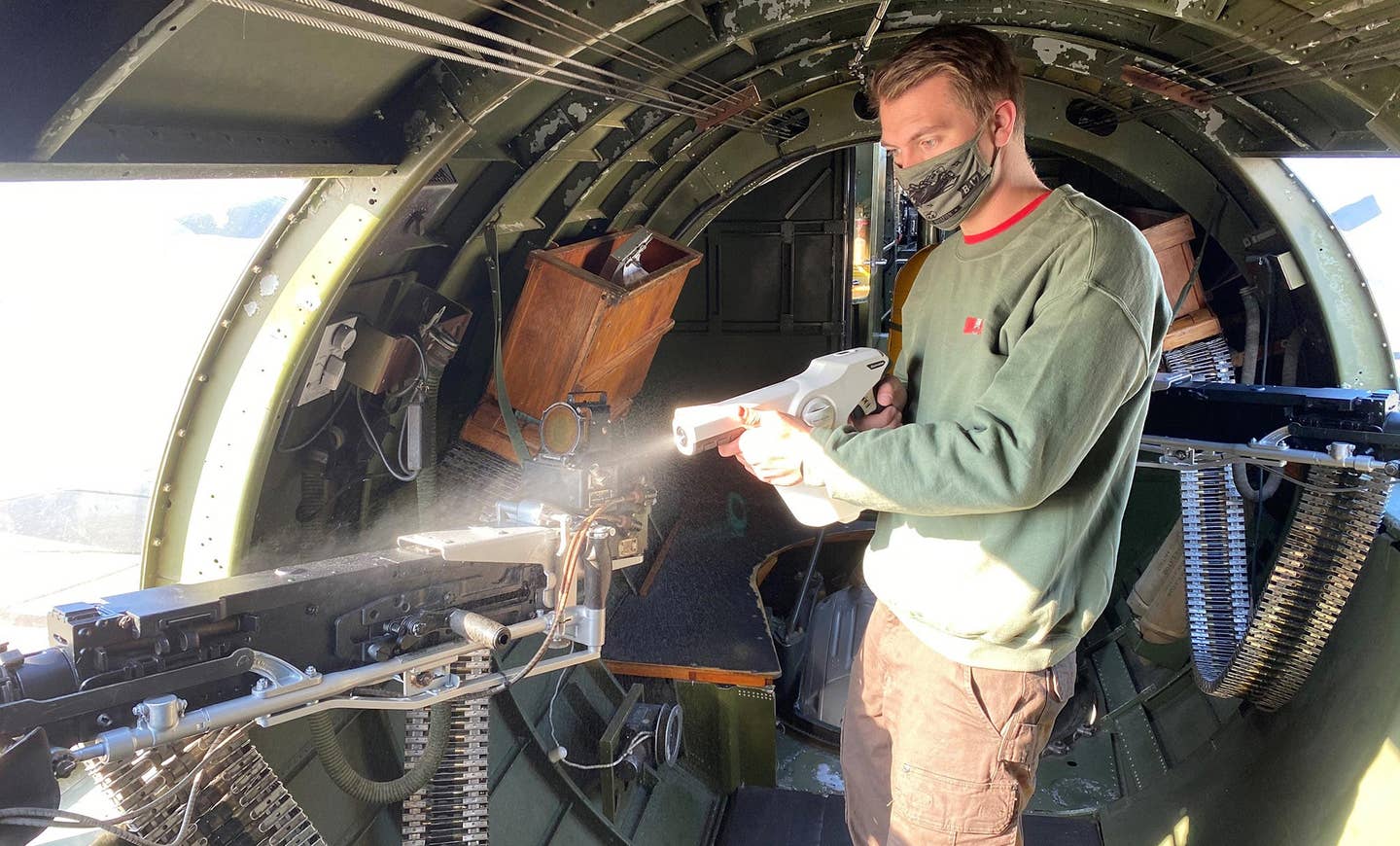
EAA tour crew chief Ken Halliday operates the COVID ionizer sanitation device inside the B-17 Aluminum Overcast during a stop in Champaign, Illinois. EAA photo/Sean Elliott
Just like so many events and public spaces that have experienced closures and cancellations this year, the Experimental Aircraft Association was forced to pull the plug on the popular national tour of their beautiful restored B-17 bomber Aluminum Overcast earlier in 2020 because of health concerns arising from the COVID-19 pandemic. Now, with new safety measures in place, EAA has resumed public tour stops of the B-17 Flying Fortress, limited for now to missions that can be conducted out and back from the association’s headquarters in Oshkosh, Wisconsin.
B-17 tour organizers explained that for now, the Aluminum Overcast tour stops are for flights only, with no ground tours allowed. The downtime between public flights will give the tour crew time for additional sanitizing of the aircraft between flights using a COVID-19 ionizing fogger. All ground and flight crew plus media and passengers are also required to wear face coverings.
There is not currently a formal tour planned. A stop in partnership with EAA Chapter 33 in Cedar Rapids, Iowa, on October 23 to 25 saw 109 prospective riders pre-book, with the B-17 making 14 total flights, despite tricky weather. Aluminum Overcast was scheduled to visit at the University of Illinois-Willard airport in Champaign, Illinois, this past weekend. Further stops are being developed at this time, and EAA advises interested passengers to visit their B-17 web page for updates and information.
The Flight Operations team at EAA had spent seven months communicating with chapters, prospective airport hosts, and other operators, and during that time developed the new out-and-back tour stop model to ensure Aluminum Overcast could continue operating in a safe manner.
“COVID-19 was a non-issue in Cedar Rapids because our volunteers and guests treated each other with respect,” EAA manager of air tours Kristy Busse said. “The entire public from small children up to our oldest visitor self-regulated within CDC guidance. We had no issues with riders as a result of COVID-19 related changes and, in fact, the weather was a bigger factor on the weekend than anything pandemic related. We have to continue to learn because every location, airport, and host has its own unique differences and challenges, but I am confident in saying this past weekend was a safe, successful, and excellent event taking a big step in the right direction towards getting EAA’s touring aircraft back out to the public. We will continue to work with other operators and subject matter experts to evolve our procedures to best protect our visitors, local hosts, and crew.”
Even with more safety precautions in place, Busse added that the experience of flying on Aluminum Overcast has not changed. “I can tell you that the unseasonably cold temperatures, in the 30s each day, did not deter our visitors from coming off of the airplane smiling ear-to-ear. Many of our visitors brought family stories and memories showcasing their direct connection to World War II, the B-17, and the Greatest Generation. It was an honor to spend time with each of them and feel the importance of their connection to this aircraft and flight experience,” she said.
EAA’s vice president of advocacy and safety, Sean Elliott, was in the B-17′s left seat for the stop in Champaign and explained the process the association went through to again bring Aluminum Overcast out to the public. “We wanted to get the B-17 out before the end of the year, as people have been asking when we would return to touring the aircraft. We also understood that we could not operate under the same procedures as in the past because of the current COVID situation. Our Flight Operations team spent a lot of time planning how we would accomplish it. As we planned, we used the latest CDC guidance, input from local health officials, and studied best practices such as what the airlines are doing right now. We also worked with local EAA chapters as potential hosts, determining what the public health and confidence levels were in their communities. All of these elements needed to work together to be successful. To have this opportunity late this year gives us a jump start on things we can do as we plan the 2021 tour,” Elliott said.
Aluminum Overcast represents the iconic B-17 bomber family well. Originally delivered in 1945, the B-17G is powered by four 1,200-horsepower, nine-cylinder Wright Cyclone Model R-1820-97 engines spinning three-bladed Hamilton Standard propellers that are 11 feet, 7 inches in diameter. With a gross wartime weight of 65,500 lbs and ability to tanker 1,700 gallons of fuel, the B-17G had a range of 1,850 nm in its standard configuration. That range could be considerably extended when the airplane carried 3,630 gallons of fuel using auxiliary “Tokyo Tanks.”
According to an EAA fact sheet on Aluminum Overcast, a little-known fact about the B-17G’s armaments is that while the 13 Browning M-2 .50 caliber machine guns could fire at a rate of approximately 13 rounds per second, no gun onboard carried more than one minute’s supply of ammunition.
EAA says “Aluminum Overcast is more than just an airplane. It is a living tribute to the brave individuals who served, sacrificed, and, in many cases gave up their lives defending freedom during World War II.” To help keep their B-17 flying for future generations, EAA asks that anyone interested in donating visit this page.

Subscribe to Our Newsletter
Get the latest FLYING stories delivered directly to your inbox






